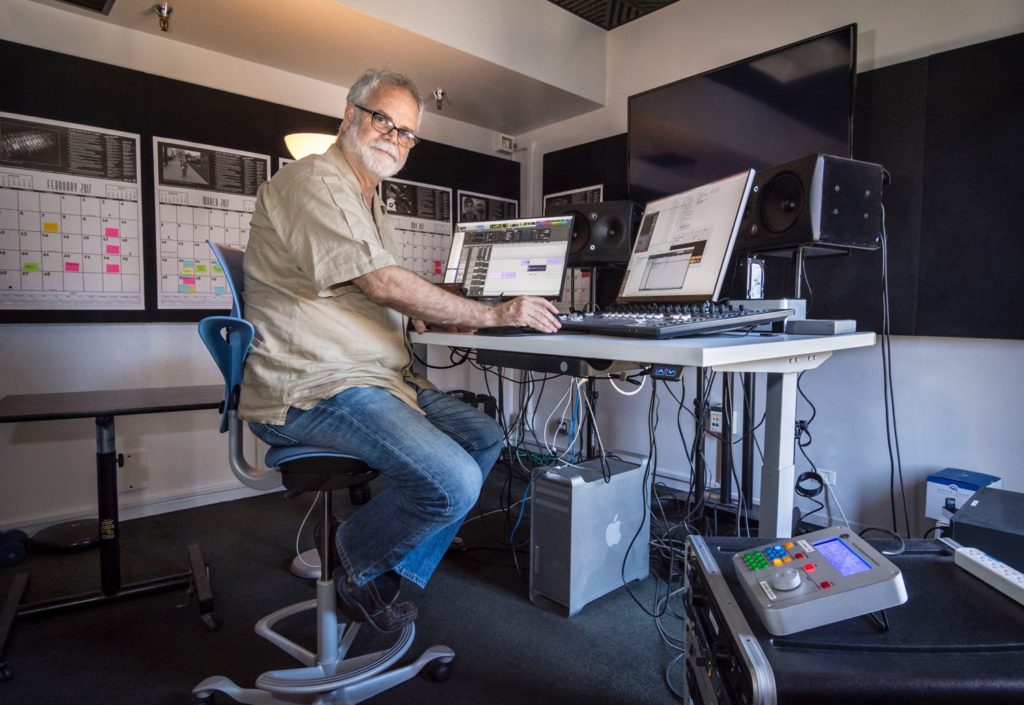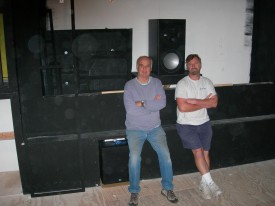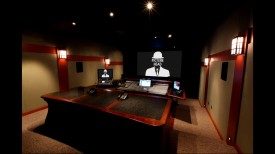A new audio post powerhouse, Sonic Union, soared onto the scene last fall in New York City’s famed Union Square. An alliance of industry veterans, Michael Marinelli (formerly of Buzz/NY) and Steve Rosen(formerly of HSR/NY), Sonic Union’s clientele includes the top advertising agencies such as BBDO, McCann Erickson, Publicis, Saatchi & Saatchi, Fallon, DDB, J.W.T, Crispin Porter + Bogusky, Y&R, and many more.
Situated in the historic 19 Union Square West building, Sonic Union is a uniquely built 8,000 square foot recording, mixing and finishing environment, comprised of four inventive, 5.1 surround mixing suites and a multi-functional, 5.1 mixing and picture finishing room—all outfitted with Blue Sky monitoring systems. It is also one of the first from-the-ground-up/new construction post facilities to emerge in NYC in over a decade.
“Being in midtown Manhattan during the boom years, when it was the center of advertising and editorial in New York, was incredibly beneficial in establishing our careers,” explained Rosen. “Over the last ten years though, the center of ‘our world’ has moved a bit further downtown, and we sought to relocate and build from scratch, a facility that exceeded on every level, the standards that we’d set in our previous incarnations, and to do that in a location that more closely mirrored our main clients.”
The eight-month, massive construction undertaking was conceived and spearheaded by studio designer and acoustician, Richard Alderson (who had previously designed Marinelli’s Buzz studio in 1994), working in concert with noted designer Raya Ani, and architectural firm Sawicki Tarella. The project was overseen by SU Managing Director and partner Adam Barone.
“Raya Ani and Richard worked hand in hand, each delivering a unique perspective in achieving our goals,” said Barone. “Raya helped us design an extremely organic feeling environment with a preponderance of curved walls and natural, sustainable materials, and low-impact LED lighting, while Richard created the shapes and design of the interiors of the mix rooms, with an eye towards extremely clean, uncolored sound. Together, they’ve given us a space that by our estimation is one of the most unique post facilities in the country.”
“I have decades of experience designing audio post rooms and therefore fully understand what these clients expect in terms of sound, feel, and look,” Alderson said. “Having a imaginative designer like Raya was a real plus for me. She was very sympathetic and accommodated a lot of the concepts that I wanted sonically in the rooms and in the physical way that they were laid out and so forth. Working as partners allowed us to accomplish this complex and challenging design within the constraints of a realistic budget.”
The whole concept of the space is unique. “It’s not like any I’m aware of,” Alderson mused. “It’s bright and colorful; full of windows and light. The production rooms each have a large flat screen on the front wall (with a 110 inch projection screen in one), with all main speakers located behind a scrim so there are no visual distractions. As the video aspect is of prime importance in this kind of studio, I wanted the whole focus directed towards the screen. The surround speakers are out of the line of sight, and all the technical furniture and equipment was kept to a minimum footprint. Also, there are no conventional large consoles in the room. The mixer’s desks consist of the latest Digidesign Pro Tools 192 workstations, Euphonics’ controllers, and Grace interfaces. We were all in agreement that we didn’t want any imposing gear layouts to detract from the relaxed, open, and comfortable working environment.”
“Our client’s needs informed our every decision,” Barone added, “and they were the driving force in prescribing exactly what we needed to build to accommodate them. Our core business being advertising and broadcast sound dictated that every room needed to be 5.1 capable, and to have two of those rooms able to accommodate advertising for theatrical release as well. We also had the benefit of a clean slate with our 8000 empty square feet, and the ability to design really comfortable, fantastic sounding working rooms. Starting from scratch, while costly, has had its benefits, as we were able to specify each room to be ultra compatible with the others. In addition to sharing similar Blue Sky monitoring systems, the rooms are outfitted identically hardware wise allowing for quick room changes with little loss of time.”
A range of Blue Sky 5.1 monitoring components was integral to each of the room’s design plan. The larger rooms (approx 35×25’) included (3)SAT 12s, a SUB 15 Universal, and a Bass Management Controller (BMC MK II), plus (6) I/ON passive studio monitors. The smaller (15×30’) rooms also featured a half-dozen I/ON’s, in addition to the newSat 8/Sub 212 monitors with a BMC MK II. The finishing room and the client lounge were each outfitted with MediaDesk 5.1 systems.
“After having worked with nearly every existing loudspeaker system, I chose Blue Sky for this critical audio component,” Alderson explained. “I knew precisely what they were capable of and designed and built SUs rooms to enhance their functionality. I’m pretty adamant about doing that. I can’t imagine building a proper room and then installing just any speakers in it. The room’s design and acoustic character must function interactively with the main audio monitors.”
Even the I/ON speaker placement was innovative in and of itself. Rather than conventionally mounting them on-wall or in-wall as they were originally intended, the six surround speakers were hung above the line-of-sight throughout each room. “We hung the surround speakers because it was the only way we could integrate them into the physical shape of the room,” Alderson clarified. “Because they couldn’t be in side walls in our design we placed them 7.5 feet from the floor and angled them down toward the mixer and clients for the focus I was looking for. In that sense, they emulate a movie theatre where you have speakers on the sidewalls directed down at the audience.”
Rosen says they couldn’t be happier with the decision to go with the Blue Sky systems. “We first looked to Blue Sky simply through researching other’s experiences with them,” adds Rosen. “References gleaned from various user groups, and industry peers led us to our first demo, in which we were simply blown away. The phrase, ‘If it’s good enough for Skywalker Sound/Lucasfilm, it’s good enough for us,’ was spoken on more than one occasion.”
“Having had some time to actually work with our Blue Sky surround systems, we can honestly say, they’re the best day-to-day studio monitors we’ve ever had the fortune to work with” says Marinelli. “The translation of our mixes to broadcast and cinema has been nothing short of remarkable, especially in a brand new facility. In the past it’s taken some time to acclimate to a new set of studio monitors, learning their characteristics and compensating for them for final broadcast. The Blue Sky’s have eliminated that for us, and provided us with a seamless transition into a new workflow with zero learning curve.”
With the growth of the downtown post-production community, the new facility places Sonic Union at the epicenter of many of the city’s elite editing and post houses.
“Our goal with Sonic Union was to create a centrally located space where clients immediately felt at ease,” said Barone, “an inviting and comfortable environment designed specifically for them. Gutting an entire floor of a pre-war corner building overlooking the Square, we bucked conventional layouts, designing a modern workspace that’s both talent and client friendly. We’re very happy with both the feel and function of the workspace, and feel the new, independent Sonic Union legitimately offers the best creative one-two punch anywhere in the industry.”
And the feedback has been overwhelming in terms of how comfortable the rooms, and how good they sound. “Our clients’ feedback thus far has been overwhelmingly positive,” Rosen concluded, “and that’s ultimately the true test of our success.”
ABOUT SONIC UNION
Some unions are meant to be. This was clearly the case when NYC uber-mixers Michael Marinelli and Steve Rosen formed Sonic Union in November 2008. Joining fellow co-founder Adam Barone in a newly built out, startlingly mod space like no other, the team offers top agency and editorial players an unsurpassed recording, mixing and finishing resource in Manhattan’s Union Square. Marinelli and Rosen have long been breaking sound barriers in the industry for leading brands and agencies. Both known for their unique style, creative expertise and industry experience, they bring the highest level of technical expertise to every job. Thoughtfully conceived and exactingly executed, Sonic Union is poised to become a top destination for world-class audio post.
For more information, go to: www.sonicunion.com
By Diane Gershuny
 LOS ANGELES – March 2017 — It’s not unusual for motion picture sound editors and sound designers to move into temporary facilities during post production, often working in acoustically challenging rooms. To optimize his 5.1 monitor system as he moves from one location to the next, freelance supervising sound editor, sound designer and mixer Douglas Murray added a Blue Sky Audio Management Controller (AMC) to his system in 2016, making particular use of its EQ curve settings and centralized level control.
LOS ANGELES – March 2017 — It’s not unusual for motion picture sound editors and sound designers to move into temporary facilities during post production, often working in acoustically challenging rooms. To optimize his 5.1 monitor system as he moves from one location to the next, freelance supervising sound editor, sound designer and mixer Douglas Murray added a Blue Sky Audio Management Controller (AMC) to his system in 2016, making particular use of its EQ curve settings and centralized level control.





